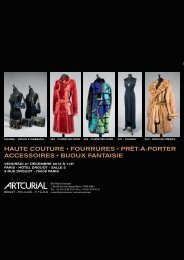Gazette Drouot - C apencheres
Gazette Drouot - C apencheres
Gazette Drouot - C apencheres
Create successful ePaper yourself
Turn your PDF publications into a flip-book with our unique Google optimized e-Paper software.
THE MAGAZINE EXPLORING<br />
A princely collection in Stockholm<br />
Overlooking a wooded estate in the<br />
heart of Stockholm on the shores of<br />
the Baltic, the Waldemarsudde<br />
Museum was designed as a temple<br />
of art by Prince Eugen of Sweden.<br />
In the first few pages of Kaputt, written in the<br />
Forties, Malaparte describes the narrator's long<br />
meeting with the Prince of Sweden. Dusk is falling<br />
slowly over Waldemarsudde, the majestic mansion<br />
where the son of Oscar II lives. Cool shadows creep<br />
over the wooded island of Djurgården, facing the<br />
salt waters of the Baltic around Stockholm, even<br />
dimming the contours of the lush gardens and<br />
Rodin's “Le Penseur” within them. We are in the<br />
middle of the Second World War and while the<br />
world is in turmoil, the narrator, who has seen his<br />
share of horrors, can take in a welcome breath of<br />
oxygen in this unspoiled environment. Prince<br />
Eugen had the Waldemarsudde built at the end of<br />
the 19th century under the supervision of Ferdinand<br />
Boberg, the architect of the Stockholm central<br />
post office and the Swedish pavilion in the Paris<br />
Universal Exhibition of 1900. The Prince moved in<br />
during 1905, living there until his death in 1947. The<br />
following year, in accordance with his last wishes,<br />
the mansion was opened to the public as a<br />
museum, virtually without any changes. At the time,<br />
this donation of works of art by their former owner<br />
was unrivalled in the history of Sweden, and represented<br />
the largest collection in the kingdom after<br />
Stockholm's Nationalmuseum and Göteborg's<br />
Konstmuseum. The patron of several contemporary<br />
artists he knew well, and a great collector, Prince<br />
Eugen built up such a huge collection that his<br />
130 GAZETTE DROUOT INTERNATIONAL I N° 19<br />
house was no longer big enough, so he had a<br />
special gallery built in 1913 that he opened to the<br />
public from time to time. This contains major paintings<br />
by Richard Bergh, Eugen Jansson and Anders<br />
Zorn, a great specialist in women's portraits,<br />
notably present with one of Queen Sophia of<br />
Sweden. We also find Per Ekström, Georg Pauli,<br />
August Strindberg and Ernst Josephson, whose<br />
works include "Strömkarlen" (The Water Sprite) of<br />
1884, probably his most famous painting, showing<br />
an Adonis-like violin player in the waves. Prince<br />
Eugen's collection represents the very source of<br />
Scandinavian art. Himself a tainted landscape<br />
painter, the Prince understood and appreciated his<br />
artist friends, whom he frequently supported by<br />
buying their works. As you go through the rooms<br />
you find several of the Prince's paintings, like the<br />
iconic "Det gamla slotted" (The Old Castle) and<br />
"Molnet" (The Cloud). His Symbolism-imbued work<br />
includes numerous pictures of mysterious Nordic<br />
forests. This magical atmosphere continues<br />
unabated in the elegant saloons with their sculptures<br />
by Carl Milles, a major figure in Sweden,<br />
whose works are also dotted around the gardens. In<br />
the saloons, from which you can see the calms<br />
waters of Stockholm, when the garden dims to blue<br />
in the evening, you fancy you can still see a slim, silkclad<br />
figure passing by: the old aristocrat who made<br />
such a success of his double life as patron and artist.<br />
Alexandre Crochet<br />
I<br />
Waldemarsudde, Prins Eugen väg 6, Djurgården, Stockholm,<br />
Sweden www.waldemarsudde.com<br />
W




